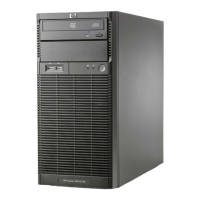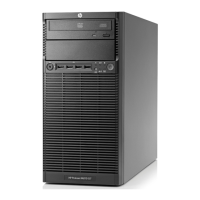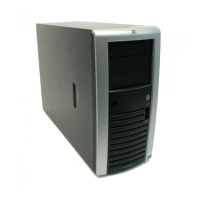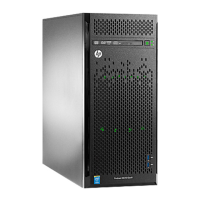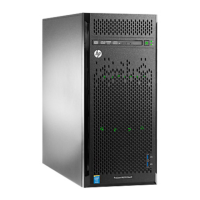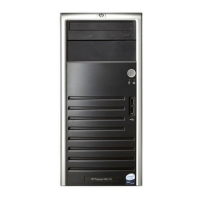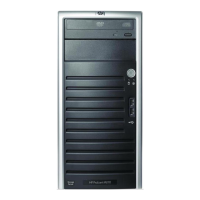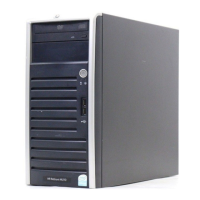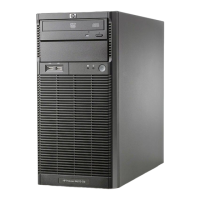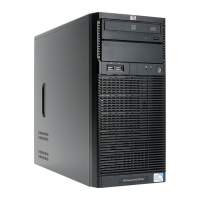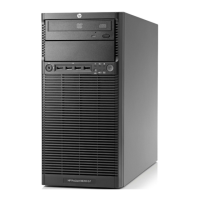





Do you have a question about the HP ProLiant ML110 and is the answer not in the manual?
| Product Line | ProLiant |
|---|---|
| Server Type | Tower |
| Processor | Intel Xeon E3-1200 series |
| Chipset | Intel C202 |
| Memory Slots | 4 |
| Storage | SATA Hard Drives (HDDs) or Solid State Drives (SSDs) |
| Drive Bays | 4 LFF or 8 SFF |
| RAID Support | RAID 0, 1, 10 |
| Form Factor | Tower |
| Management | HP iLO |
| Operating System Support | Windows Server, Linux, VMware |
| Memory | DDR3 or DDR4 ECC Unbuffered DIMMs (UDIMMs) (depending on the specific generation) |
Information about the target audience for this guide.
Important notes and warnings for service technicians handling the equipment.
Resources and contacts for further assistance with the server.
Contact numbers for HP authorized resellers and technical support.
Overview of the server's key hardware and software capabilities.
Detailed physical, environmental, and power requirements of the server.
Supported Network Operating Systems and diagnostic tools for the server.
Description of the server's physical external components and layout.
Detailed description of the server's rear panel ports and connectors.
Details on the server's internal components and their arrangement.
Identification and description of components located on the server's mainboard.
Preliminary checks and site selection considerations before system setup.
Instructions for connecting essential peripherals like keyboard, mouse, and monitor.
Steps for connecting USB mouse and keyboard to the server.
Guide for connecting a monitor to the server's video port.
Instructions for connecting serial, parallel, or USB printers to the server.
Procedures for safely powering the server on and off.
Explanation of different power-saving sleep modes supported by the server.
Information on system activities that can trigger wake-up events from sleep states.
Procedures for installing and configuring server hardware components.
Steps for removing and reinstalling the server's side cover and front bezel.
Detailed instructions for removing and reinstalling the server's left-side cover.
Steps for removing and reinstalling the server's front bezel.
General procedures for configuring server hardware, including pre/post steps.
Information on installing default mass storage devices like CD-ROM and FDD.
Procedures for replacing the floppy disk drive (FDD) in the server.
Instructions for installing optional drives in the server's common bay.
Procedures for installing and removing hard disk drives from the HDD cage.
Steps for removing and installing the server's processor, including thermal paste application.
Details on server memory types, slots, and operating modes.
Step-by-step instructions for removing a DIMM from the server's memory slot.
Step-by-step instructions for installing a DIMM into the server's memory slot.
Instructions for installing and removing PCI cards in the server's expansion slots.
Procedures and warnings for replacing the server's internal lithium battery.
Steps for replacing the server's power supply unit (PSU).
Instructions for removing and installing the server's system fan.
Methods to configure the HP ProLiant ML110 server using provided resources.
Introduction to the BIOS Setup Utility and its purpose for system configuration.
Steps to enter and navigate the BIOS Setup Utility interface.
Navigating the BIOS Utility and understanding setting parameters.
Importance of recording BIOS settings for future reference or restoration.
Viewing the System Summary Screen for server configuration details.
Setting up and managing supervisor and user passwords for system security.
Step-by-step guide to setting system passwords in the BIOS.
Instructions for modifying existing system passwords.
Steps to clear or remove a system password from BIOS settings.
Procedures for resetting a forgotten system password via hardware switch.
Options for exiting the BIOS Setup Utility, including saving or discarding changes.
Procedures for updating or recovering the server's BIOS firmware.
Guide to creating a bootable diskette for BIOS updates or recovery.
Step-by-step guide to updating the server's BIOS to the latest version.
Instructions for resetting BIOS settings to factory default values.
Procedures for recovering the system BIOS if it becomes corrupted.
Steps to clear CMOS memory to reset BIOS configuration settings.
Options to lock or unlock specific hardware devices for access control.
Guidelines for routine cleaning and maintenance of server components.
Comprehensive steps and resources for diagnosing and resolving system problems.
Information on how to obtain technical support from HP.
Systematic approach to identify the root cause of server problems.
Detailed troubleshooting steps for common server issues.
Specific troubleshooting steps for issues related to server power.
Troubleshooting common issues with input/output devices like video and monitors.
Steps to resolve issues with the CD-ROM drive not opening or functioning.
Troubleshooting common problems related to SCSI controllers and devices.
Steps to resolve issues with IDE devices not working or being detected.
Introduction to the server's diagnostic functions and error message types.
Explanation of the Power-On Self-Test process and its role in hardware diagnostics.
Understanding POST error messages and beep codes for system failures.
Common POST error messages and their corrective actions.
Interpretation of beep codes indicating POST errors or hardware failures.
Procedures to follow when POST fails to run or display errors.
Information on using diagnostic software to test server hardware integrity.
Guide to using the Diagnostics for Windows utility for server verification.
Introduction to SATA technology and its implementation on the server.
Step-by-step guide for installing SATA drives into the server's hot-plug cage.
Instructions for creating a driver diskette for the RAID controller.
Interpretation of SATA LED indicators for device status.
FCC compliance information for the server, including Class B equipment.
FCC declaration of conformity statement for US products.
Compliance information for Canada, including Class B equipment regulations.
Information regarding CE Marking, EMC, and Low Voltage Directives for EU compliance.
Compliance information specific to Japan.
Compliance information related to BSMI.
Compliance information related to Korean MIC.
Safety notices and compliance information related to the laser device.
Warnings and guidelines for safely replacing the server's internal battery.
Disclaimer regarding the use of servers in nuclear facilities.
Methods to prevent damage to sensitive components from static electricity.
Techniques and tools for proper grounding when handling electronic parts.
General specifications for power cord sets applicable across all countries.
Details on accredited agencies and specific requirements for power cords by country.
